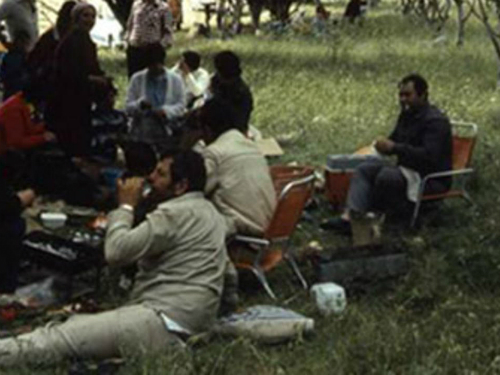
Ma’aloul is a Palestinian village in Galilee. In 1948, it was destroyed by the Isreali armed forces and its inhabitants expelled either to Lebanon or to the neighboring town of Nazareth. Ever since, the former inhabitants of Ma’aloul are only allowed to visit it once a year on the anniversary of Israel’s independence and have developed a tradition of organizing a picnic on this day on the very site of the destroyed village.
“One of the reasons that Khleifi’s films resound, I believe, with so many people, and myself included, is that they are so human. He aims to make visible l’invisible, trauma, memory, the human experience, and give that or they who cannot be seen the same level of drama and complexity as the universe, with equal importance and weight, and with all of the emotions we are capable of: despair, hope, joy, sadness... ”
Rebecca Jane Arthur1
“While editing Fertile Memories, Khleifi discovered that part of the footage he had accumulated from the destroyed village of Ma’aloul was not connected to the plot of the two women. It belonged, in fact, in another film. This film, Ma’aloul Celebrates its Destruction, was consequently made in 1984. It continues the efforts previously [made] in Adnan Mdanat’s film Palestinian Visions (1977), to resurrect Palestinian memory using different kinds of media. In Ma’aloul Celebrates its Destruction, these means include a mural of Ma’aloul village on the wall of a refugee’s house, documentary and semidocumentary footage, and testimonies of the refugees themselves as well as a historical delineation of the conflict narrated by a schoolteacher. In addition, a stroll among the village ruins and the time spent there on Israeli Independence Day, when Arab families were allowed to leave the areas under the rule of the military government and wander around Israel, add another layer.
As in Mdanat’s films, the combination of these means enables both the preservation and the destruction of the harmonious image of the idyllic past. Khleifi’s film, however, takes this a step further, anticipating trends that would only take root several years later. Alongside the static preservation of an enchanted past image, it also excavates the layers of memory. Thus it transforms the static narrative of the past resurrected in the present into a story of the remembrance of the past, its recognition and processing, as a working through, as a stage toward a return to life in the present and its continued progression to the future.
[...]
While bringing the past alive in the present, the film also indicates the gap between these two periods of time. It is the length of time passed by the walker in the village, who is searching for the remains of his home and finds them whilst walking the distance between the ruins among which Palestinian children play during the course of Independence Day, and the village, which they do not know. It is the gap between history, as the village teacher recounts it to his students, in compliance with Israeli Ministry of Education requirements, and the subjective destiny of those defeated by it, including that same teacher, who is a Ma’aloul refugee. Above all, it is the distance between the two histories: the history of the Jews as quoted by the teacher and reenacted by the director, and Arab history as documented through individual reminiscences. Ma’aloul Celebrates its Destruction thus indicates the differences necessary for the recounting of a full historical narrative. These are the differences between time and time, between memory and memory, between the place that was and the one that is, between the two peoples. The film integrates the traumatic story and the story of the attempt to overcome it. Thus it offers a history of trauma as well as another history - that comprised of the double image: present/past, two representations simultaneously illuminating and obscuring each other.”
Nurith Gertz and George Khleifi2

